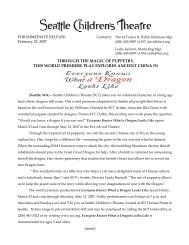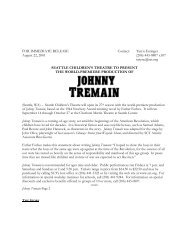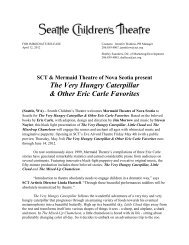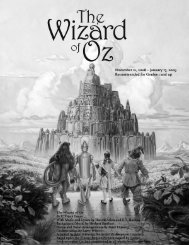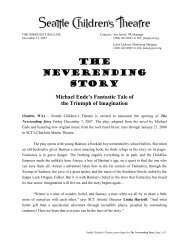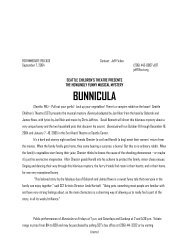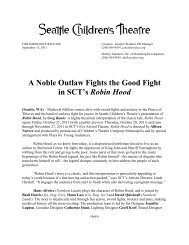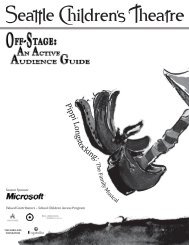Harold and the Purple Crayon - Seattle Children's Theatre
Harold and the Purple Crayon - Seattle Children's Theatre
Harold and the Purple Crayon - Seattle Children's Theatre
- No tags were found...
Create successful ePaper yourself
Turn your PDF publications into a flip-book with our unique Google optimized e-Paper software.
EDUCATOR RESOURCE GUIDE<strong>Harold</strong> <strong>and</strong> <strong>the</strong> <strong>Purple</strong> <strong>Crayon</strong>Lyrics by Rob Burgess, Music by Auston James <strong>and</strong> Book by DonDarryl Rivera; Based on <strong>the</strong> books by Crockett Johnson; All RightsReserved by The Estate of Ruth Krauss, Stewart I. Edelstein, ExecutorSEPT 22 - OCT 30, 2011AGES 4+Grades PreK+SEASONSPONSORS
presentsTable of ContentsSynopsis................................................................................................................. 3Curriculum Connections <strong>and</strong> EALRs......................................................... 4-5Crockett Johnson - The Man Behind <strong>the</strong> Books.................................... 6Where it All Began............................................................................................ 7-8A Chat with Stefan Gruber, Animator........................................................ 9About <strong>the</strong> Puppets............................................................................................ 10-11Making <strong>Harold</strong>’s World................................................................................... 12-13How Are You Going To Do That?................................................................. 14Draw a Story, Paint a World.......................................................................... 15-16Words That Might Be New To You.............................................................. 17Activity Page........................................................................................................ 18Booklist.................................................................................................................. 19Evaluation Form................................................................................................. 202
SYNOPSIS<strong>Harold</strong> is a creative little boy with an extraordinary crayon. When we first meet him, he ishappily drawing <strong>and</strong> wondering what his next adventure should be. With a sudden burst ofinspiration, he sketches <strong>the</strong> moon <strong>and</strong> a horizon that leads out of his room <strong>and</strong> into <strong>the</strong>enormous realm of his imagination.His first stop is a clearing where he draws seeds to plant <strong>and</strong> acloud to water <strong>the</strong>m. Trees grow into a forest filled with creaturesthat welcome <strong>Harold</strong>. When he’s hungry, he draws himselfan apple tree, but can’t seem to keep <strong>the</strong> fruit for himself. So hedraws a dragon to guard <strong>the</strong> tree. His drawing is a little too good.The dragon scares <strong>Harold</strong> <strong>and</strong>, as he nervously backs away fromit, he finds himself falling into an undersea world. He discovers asunken ship <strong>and</strong> a mischievous puffer fish. Toge<strong>the</strong>r <strong>Harold</strong> <strong>and</strong>his new friend evade a pinching crab, restore <strong>the</strong> boat <strong>and</strong> sail offacross <strong>the</strong> sea with <strong>the</strong> moon following along.<strong>Harold</strong> <strong>and</strong> <strong>the</strong> puffer fish part ways when <strong>the</strong>y reach an isl<strong>and</strong>.<strong>Harold</strong> steps into <strong>the</strong> center of an argument between a porcupine<strong>and</strong> moose. They are cranky because <strong>the</strong>y’re hungry. <strong>Harold</strong> canhelp with that. He draws an enormous pie that accidentally fallsright atop <strong>the</strong> porcupine. During <strong>the</strong> playful food fight thatfollows, pie gets on everything. Including <strong>the</strong> moon. <strong>Harold</strong> feels responsible for <strong>the</strong> mess <strong>and</strong>sets off in a rocket ship to do some cleaning up. Unfortunately, <strong>the</strong> rocket packs more power thanhe can h<strong>and</strong>le <strong>and</strong> he goes shooting past <strong>the</strong> moon into deep space.Just as he gets <strong>the</strong> moon back in his sight, an alien spaceship careens towards him. They collide<strong>and</strong> go plummeting to a distant planet. <strong>Harold</strong> helps <strong>the</strong> alien pilot repair his ship <strong>and</strong> hitches aride home. But first <strong>the</strong>y stop by <strong>the</strong> alien’s home where <strong>Harold</strong> is made an honorary citizen. In<strong>the</strong> midst of <strong>the</strong> celebration, <strong>Harold</strong> gets too enthusiastic <strong>and</strong> jumps right off <strong>the</strong> planet. He floatshis way back to Earth’s atmosphere <strong>and</strong> is enjoying <strong>the</strong> beautiful clouds when he thinks he sees acloud shaped like a dragon. Wait. That’s no cloud! It is adragon. A hungry dragon who thinks crayons lookdelicious. When <strong>Harold</strong> finally manages to get hiscrayon back from <strong>the</strong> dragon, it’s broken in two. Thedragon sees how heartbroken that makes <strong>Harold</strong> <strong>and</strong>mends <strong>the</strong> crayon with some magic dragon fire.It’s been a long busy day for <strong>Harold</strong>. It’s time to gohome. He heads into <strong>the</strong> city where he gets lost in <strong>the</strong>bustle of activity around him. He can’t even find <strong>the</strong>moon to guide him. With <strong>the</strong> help of a police officer,<strong>Harold</strong> finds his way back home <strong>and</strong> into bed. He driftsoff to sleep in awe of <strong>the</strong> moon, pleased with his newfriendships <strong>and</strong> filled with peace.3
CURRICULUM CONNECTIONS & EALRS<strong>Harold</strong> <strong>and</strong> <strong>the</strong> <strong>Purple</strong> <strong>Crayon</strong> touches on many <strong>the</strong>mes <strong>and</strong> ideas. Here are a few webelieve would make good Curriculum Connections: Imagination, Creativity,Adventure, Travel, Problem Solving, Self-esteem.We believe that seeing <strong>the</strong> show <strong>and</strong> using our Educator Resource Guidecan help you meet <strong>the</strong> following EALRs:State St<strong>and</strong>ards:<strong>Theatre</strong>Visual Arts1. The student underst<strong>and</strong>s <strong>and</strong> applies arts knowledge <strong>and</strong> skills.1.1 Underst<strong>and</strong> arts concepts <strong>and</strong> vocabulary, specifically, identifies <strong>and</strong> describescharacters, setting, actions, conflict, sounds1.2 Develops <strong>the</strong>atre skills <strong>and</strong> techniques.1.4 Underst<strong>and</strong>s <strong>and</strong> applies audience conventions in a variety of settings <strong>and</strong>performances of <strong>the</strong>atre.3. <strong>Theatre</strong>: The student communicates through <strong>the</strong> arts (dance, music, <strong>the</strong>atre, <strong>and</strong>visual arts).3.1 Uses <strong>the</strong>atre to express feelings <strong>and</strong> present ideas.3.2 Uses <strong>the</strong>atre to communicate for a specific purpose.1. Visual Arts: The student underst<strong>and</strong>s <strong>and</strong> applies arts knowledge <strong>and</strong> skills indance, music, <strong>the</strong>atre, <strong>and</strong> visual arts.1.1 Underst<strong>and</strong>s <strong>and</strong> applies visual arts concepts <strong>and</strong> vocabulary.1.2 Develops visual arts skills <strong>and</strong> techniques.3. Visual Arts: The student communicates through <strong>the</strong> arts (dance, music, <strong>the</strong>atre, <strong>and</strong>visual arts).3.1 Uses visual arts to express feelings <strong>and</strong> present ideas.3.2 Uses visual arts to communicate for a specific purpose.4. Visual Arts: The student makes connections within <strong>and</strong> across <strong>the</strong> arts (dance,music, <strong>the</strong>atre, <strong>and</strong> visual arts) to o<strong>the</strong>r disciplines, life, cultures, <strong>and</strong> work.4.1 Demonstrates <strong>and</strong> analyzes <strong>the</strong> connections among <strong>the</strong> arts (dance, music,<strong>the</strong>atre, <strong>and</strong> visual arts).4.5 Underst<strong>and</strong>s how arts knowledge <strong>and</strong> skills are used in <strong>the</strong> world of work,including careers in <strong>the</strong> arts.Continued on <strong>the</strong> next page...4
ReadingScienceCommunicationState St<strong>and</strong>ards continued:1. The student underst<strong>and</strong>s <strong>and</strong> uses different skills <strong>and</strong> strategies to read.1.1 Use word recognition skills <strong>and</strong> strategies to read <strong>and</strong> comprehend text.1.2 Use vocabulary (word meaning) strategies to comprehend text.1.3 Build vocabulary through wide reading.1.4 Apply word recognition skills <strong>and</strong> strategies to read fluently.2. The student underst<strong>and</strong>s <strong>the</strong> meaning of what is read.2.1 Demonstrate evidence of reading comprehension.2.3 Exp<strong>and</strong> comprehension by analyzing, interpreting, <strong>and</strong> syn<strong>the</strong>sizinginformation <strong>and</strong> ideas in literary <strong>and</strong> informational text.2.4 Think critically <strong>and</strong> analyze author’s use of language, style, purpose, <strong>and</strong>perspective in literary <strong>and</strong> informational text.3. The student reads different materials for a variety of purposes.3.1 Read to learn new information.3.2 Read to perform a task.3.4 Read for literary experience in a variety of genres.EALR 2: Inquiry. Big Idea: Inquiry (INQ). Core Content: Making ObservationsStudents learn that scientific investigations involve trying to answer questionsby making observations or trying things out, ra<strong>the</strong>r than just asking an adult.Children are naturally curious about nearly everything—butterflies <strong>and</strong> clouds,<strong>and</strong> why <strong>the</strong> Moon seems to follow <strong>the</strong>m at night. The essence of this st<strong>and</strong>ard isto channel students’ natural curiosity about <strong>the</strong> world, so that <strong>the</strong>y becomebetter questioners, observers, <strong>and</strong> thinkers, laying <strong>the</strong> groundwork forincreasing underst<strong>and</strong>ing <strong>and</strong> abilities in science inquiry in <strong>the</strong> years to come.1. The student uses listening <strong>and</strong> observation skills <strong>and</strong> strategies to gainunderst<strong>and</strong>ing.1.1 Uses listening <strong>and</strong> observation skills <strong>and</strong> strategies to focus attention<strong>and</strong> interpret information.1.2 Underst<strong>and</strong>s, analyzes, syn<strong>the</strong>sizes, or evaluates information from avariety of sources.5
CROCKETT JOHNSON - THE MAN BEHIND THE BOOKSCrockett Johnson in 1943, with <strong>the</strong> cover drawing for BarnabyCrockett Johnson was born DavidJohnson Leisk on October 20, 1906, in NewYork City. He chose his pen name because, ashe said, “Crockett is my childhoodnickname. My real name, Leisk, was too hardto pronounce - so - I am now CrockettJohnson!” According to <strong>the</strong> Third Book ofJunior Authors, he was “six feet tall, tan, husky,<strong>and</strong> blue-eyed”. Like Barnaby <strong>and</strong> <strong>Harold</strong>,his most famous characters, Johnson wasbald. “I draw people without hair becauseit’s so much easier! Besides, to me, peoplewith hair look funny.”For a man who described himself as “<strong>the</strong> laziest man in <strong>the</strong> world” <strong>and</strong> claimed that he neverintended to be an artist, Johnson had a remarkably productive artistic career. Before he becamea well-known writer <strong>and</strong> illustrator of children’s books, he created some of <strong>the</strong> most belovedcomic strip characters of <strong>the</strong> 20th century. Barnaby first appeared in a newspaper on April 20,1942. The comic followed <strong>the</strong> adventures of a little boy named Barnaby Baxter <strong>and</strong> Mr. O’Malley,his bumbling Fairy Godfa<strong>the</strong>r. Barnaby’s parents never saw <strong>the</strong> Fairy Godfa<strong>the</strong>r, but readersknew he existed.Johnson’s first book, Who’s Upside Down?, was published in 1952. He wrote <strong>and</strong> illustrated over20 books for children, providing illustrations (but not <strong>the</strong> story) for seven more. <strong>Harold</strong>, <strong>the</strong> heroof his best-known series, began his many journeys in <strong>Harold</strong> <strong>and</strong> <strong>the</strong> <strong>Purple</strong> <strong>Crayon</strong> in 1955. Thiswas followed by <strong>Harold</strong>’s Fairy Tale (1956), <strong>Harold</strong>’s Trip to <strong>the</strong> Sky (1957), <strong>Harold</strong> at <strong>the</strong> NorthPole (1958), <strong>Harold</strong>’s Circus (1959), A Picture for <strong>Harold</strong>’s Room (1960), <strong>and</strong> <strong>Harold</strong>’s ABC(1963).Johnson married author Ruth Krauss in <strong>the</strong> early 1940s <strong>and</strong> lived on <strong>the</strong> shore of Long Isl<strong>and</strong>Sound. During <strong>the</strong> 1950s, author <strong>and</strong> illustrator Maurice Sendak spent many weekends at <strong>the</strong>irhome as a friend <strong>and</strong> apprentice. Crockett Johnson finished outhis career as a fine artist, painting over 100 large, vivid canvasesof geometric forms. He died in 1975.Excerpted from:Children’s Literature Network:http://www.childrensliteraturenetwork.org/index.phpThe Crockett Johnson Homepage:http://www.k-state.edu/english/nelp/purple/index.html6
WHERE IT ALL BEGANWe asked Auston James,Don Darryl Rivera <strong>and</strong> RobBurgess, <strong>the</strong> creators of thisadaptation of <strong>Harold</strong> <strong>and</strong> <strong>the</strong> <strong>Purple</strong><strong>Crayon</strong>, to get toge<strong>the</strong>r <strong>and</strong> talkabout how <strong>the</strong>y wrote this show.DON: Shall we start?ROB: We should get a picture. Where’s<strong>the</strong> timer on this? (camera chimes)Alright!(Flash!)ROB: OK. Well, ok - we want to start at <strong>the</strong> beginning when Don Darryl had <strong>the</strong> idea. We were in<strong>the</strong> SCT dressing room...AUSTON: Wait! Let’s make up an interesting story. We were at NASA training in Huntsville, AL...ROB: The way I remember it, we were on a cruise <strong>and</strong> <strong>the</strong>y had told us that it was fresh squeezedorange juice <strong>and</strong> it was clearly frozen <strong>and</strong> we were miffed. I <strong>the</strong>n recalled a drink that my mo<strong>the</strong>rmade called Swamp Water, made with orange juice <strong>and</strong> grape Kool-Aid...DON: Well, it actually happened as an idea that sprung up in conversation in <strong>the</strong> dressing room.Rob <strong>and</strong> I were doing If You Give A Mouse A Cookie <strong>and</strong> Auston was doing Peter Pan. Earlier thatweek I was talking to SCT’s literary manager about a show idea I had.AUSTON: See <strong>the</strong> NASA story would’ve been so much more interesting...(They all laugh!)From left to right: Auston, Don <strong>and</strong> RobROB: Don had asked me about writing lyrics, because in my I Was A Rat! bio I had mentionedthat I do that. Don said that SCT should do a new adaptation of <strong>Harold</strong>... <strong>and</strong> that I should write<strong>the</strong> lyrics, Auston should write <strong>the</strong> music <strong>and</strong> that Don was going to write <strong>the</strong> script.DON: I did a loose outline of <strong>the</strong> action of <strong>the</strong> show <strong>and</strong> <strong>the</strong> three of us came toge<strong>the</strong>r <strong>and</strong>bounced ideas off each o<strong>the</strong>r. I <strong>the</strong>n went <strong>and</strong> wrote 27 pages of stage directions - <strong>the</strong> action of<strong>the</strong> play. We wanted to use three of Crockett Johnson’s books: <strong>Harold</strong> <strong>and</strong> <strong>the</strong> <strong>Purple</strong> <strong>Crayon</strong>,<strong>Harold</strong>’s Trip to <strong>the</strong> Sky <strong>and</strong> <strong>Harold</strong>’s ABC. But in <strong>the</strong> end, we concentrated on using <strong>Harold</strong> <strong>and</strong><strong>the</strong> <strong>Purple</strong> <strong>Crayon</strong> <strong>and</strong> part of <strong>Harold</strong>’s Trip to <strong>the</strong> Sky.AUSTON: We thought that <strong>the</strong> first book was perfect to base <strong>the</strong> show on, but we wanted just abit more, so we added some of <strong>the</strong> action from ...Trip to <strong>the</strong> Sky.DON: I started writing <strong>the</strong> first version of <strong>the</strong> script in July 2010 <strong>and</strong> turned in <strong>the</strong> one we’ll usein rehearsal in March 2011.Continued on <strong>the</strong> next page...7
ROB: Musically, song-wise, Auston <strong>and</strong> I tried to figure out if <strong>the</strong> music or <strong>the</strong> lyrics should bewritten first.AUSTON: I had already written two songs before we even started with <strong>the</strong> script.ROB: And I sent Auston three sets of dry lyrics, or lyrics without music - which Rocket In The Skycame out of.DON: Oooh, this is exciting!ROB: The melody to <strong>the</strong> hero song Great To Be Me actually started off as <strong>the</strong> melody to <strong>the</strong> CitySong but we both agreed <strong>the</strong> song sounded more like <strong>the</strong> hero song.AUSTON: I had a bunch of tunes <strong>and</strong> melodies. I was just trying to find a spot to put <strong>the</strong>m. And soRob came over <strong>and</strong> I played a bunch of little tidbits I had for him <strong>and</strong> thought, “could we use anyof <strong>the</strong>se?”ROB: We discovered that melody first was a great way to write our songs because, you know, it’ssimpler to adjust lyrics than to adjust a composition.AUSTON: Because I write from a music side, it was hard for me to write from a dry lyric. And Robwas fast writing that way, too - like bam (he snaps his fingers)! I made sure that <strong>the</strong> music alwayshelps us underst<strong>and</strong> <strong>Harold</strong> <strong>and</strong> opens up a bigger world, too. It sets <strong>the</strong> structure for <strong>the</strong> story,something to build on.DON: Especially since <strong>the</strong>re’s no dialogue, except <strong>the</strong> singing. Should we talk about <strong>the</strong>differences between <strong>the</strong> books <strong>and</strong> our show?ROB: WOW, THAT’S MASSIVE!AUSTON: Well, <strong>the</strong> book, I mean - you imagine so many things about that little character <strong>and</strong>with our play, we’ve shown what we see in him.ROB: For me it’s like an apple pie recipe. Everyone knows apple pie, everyone knows <strong>Harold</strong> <strong>and</strong><strong>the</strong> <strong>Purple</strong> <strong>Crayon</strong> - this is our recipe for <strong>Harold</strong>. We took our three ingredients <strong>and</strong> put toge<strong>the</strong>rthis...dessert.DON: We filled it with moments of play <strong>and</strong> moments of wonder - it was like <strong>Harold</strong> <strong>and</strong> <strong>the</strong><strong>Purple</strong> <strong>Crayon</strong> was a coloring book for us <strong>and</strong> we filled it in how we wanted to.ROB: Basically, we wrote a show that we wanted to see.AUSTON & DON & ROB: Or be in!ROB: What are some of <strong>the</strong> o<strong>the</strong>r things we want audiences to look for in <strong>the</strong> show?DON: They should listen very carefully for <strong>the</strong> fun little lines between lyrics in <strong>the</strong> songs.AUSTON: And how <strong>Harold</strong> solves <strong>the</strong> problems he creates. Like Star Trek.(They all laugh!)8
A CHAT WITH STEFAN GRUBER, ANIMATORPlease tell us a little bit about your working process.Well, I make about 15 drawings for every second of animation. The firstfilm I made had a stack of drawings that went from <strong>the</strong> floor to <strong>the</strong> ceiling!I like to make animation as art, kind of like what you’d find in a museum. Ilook around <strong>the</strong> world <strong>and</strong> find things that interest me <strong>and</strong> I translate thosethings into short cartoons. It takes a ton of patience to make animation, <strong>and</strong>what’s cool is that <strong>the</strong> more animation you make <strong>the</strong> more patient you get.My animation is made sometimes using paper <strong>and</strong> ink on a light-table, <strong>and</strong>sometimes with a computer <strong>and</strong> a mouse that looks like a pen. You can makeanimation on one of those little yellow note pads by just starting a drawing on <strong>the</strong> bottom page,<strong>and</strong> tracing it a little bit on <strong>the</strong> second to bottom page, <strong>and</strong> <strong>the</strong>n continuing that until you fillup <strong>the</strong> whole pad. My first animations were done like that, <strong>and</strong> starred a slime-mold creaturenamed Smushy.What is a particularly interesting or unusual challenge on this project, <strong>and</strong> how are yousetting out to solve it?One thing we’re making is animation of a dancing tree. Our director, Rita, invited in a dancer toshow us exactly how a tree might dance while it’s growing up, <strong>and</strong> we videotaped that. I put <strong>the</strong>video on my computer screen <strong>and</strong> copied <strong>the</strong> dance movements until we had a fully animatedtree, growing up <strong>and</strong> flowing in <strong>the</strong> wind. It’s really fun working with a big team of talentedpeople. Everyone gets to inspire each o<strong>the</strong>r, <strong>and</strong> we’re all encouraged to be as creative as can be.What in your childhood got you to where you are today?In 1st grade, I wanted to grow up <strong>and</strong> be a magician. Themost fun famous magician at <strong>the</strong> time was Doug Henning,who I’d seen do magic tricks on The Muppet Show. Mymom <strong>and</strong> I saw him live at <strong>the</strong> Moore, <strong>and</strong> I was so lucky - heinvited us backstage after <strong>the</strong> show, where he taught me howto make a little foam ball disappear.This is a picture from Stefan’s animatedmovie LeashlessnessAt age 10 I saw some animation being projected outdoors at <strong>the</strong> <strong>Seattle</strong> Art Walk, <strong>and</strong> it was sobeautiful <strong>and</strong> simple. It was just a running greyhound dog drawn in pencil, running <strong>and</strong> running,<strong>and</strong> slowly it was erased a little bit at a time until <strong>the</strong> dog was gone. This was <strong>the</strong> first time I sawanimation <strong>and</strong> understood how it was made. It was like <strong>the</strong> filmmaker had taught me how toanimate, showing me how to do it through his film. My focus on magic shifted to animation, <strong>and</strong> Itook lots of classes on how to make it. When I grew up <strong>and</strong> got to animation college, I wasgreeted by my new professor Jules Engel - a 90-year-old wise man, <strong>and</strong> <strong>the</strong> maker of that verysame dog film I saw as a kid! The film is called Accident. You used to be able to see it on YouTube,but it looks best on a 16mm projector outdoors at an art walk when you’re 10.Stefan Gruber is a <strong>Seattle</strong> animator <strong>and</strong> performance artist. He creates a short h<strong>and</strong>-drawn, digitally-finished filmevery year. He hosts animation classes at Nova Alternative High School, <strong>the</strong> Frye Art Museum, <strong>and</strong> <strong>the</strong> NorthwestFilm Forum, <strong>and</strong> does a yearly screening of kid-made animation shorts.9
ABOUT THE PUPPETSFrom Annett Mateo, Puppet DesignerThis production of <strong>Harold</strong> <strong>and</strong> <strong>the</strong> <strong>Purple</strong> <strong>Crayon</strong> is a world premiere, which means that no onehas ever done this show before. To help us figure out what was needed to tell this story, we hadsome workshops where we experimented with animation, music, movement, scenery, props<strong>and</strong> puppets. It was clear that puppetry could really add to <strong>the</strong> storytelling <strong>and</strong> bring a lot of lifeto <strong>the</strong> production. I am very excited about this show because <strong>the</strong>re are more different kinds ofpuppets on stage than we have ever had before: body puppets, remote control puppets, shadowpuppets, h<strong>and</strong> <strong>and</strong> rod puppets, marionettes <strong>and</strong> more!Body puppet -The dragon that <strong>Harold</strong> runs into is a body puppet, which means it is worn by <strong>the</strong> puppeteer.That lets it be large <strong>and</strong> dramatic. Large wings give <strong>the</strong> puppet a sense of being much bigger thanit really is <strong>and</strong> that makes <strong>the</strong> puppet more important <strong>and</strong> active than if it were just a projectionor a flat object. The white flowing wings also make it seem as if <strong>the</strong> dragon is part of <strong>the</strong> cloudsin which it appears.A sketch of <strong>the</strong> dragon body puppet,seen from <strong>the</strong> frontHere’s a drawing of <strong>the</strong> dragon bodyseen from <strong>the</strong> sideRemote control puppet -At one point in <strong>the</strong> workshop, we needed something to draw<strong>Harold</strong>’s attention to <strong>the</strong> o<strong>the</strong>r side of <strong>the</strong> stage. We thought abouthim watching a squirrel scooting across <strong>the</strong> stage. We used a roll oftape to st<strong>and</strong> in for <strong>the</strong> squirrel. As I was st<strong>and</strong>ing <strong>the</strong>re rolling <strong>the</strong>tape across <strong>the</strong> stage, I got <strong>the</strong> idea that it would be perfect to put<strong>the</strong> puppet on a remote-control car body <strong>and</strong> <strong>the</strong>n it could reallyscamper like a squirrel!Continued on <strong>the</strong> next page...10A drawing of <strong>the</strong> remotecontrol squirrel
Shadow puppet -A shadow puppet is not like o<strong>the</strong>r puppets, because it is never actually seen. Instead, we see <strong>the</strong>shadow it makes when a light shines on it. Shadow puppetry is so magical because we canclearly recognize shapes, while we play with size, distance, <strong>and</strong> where objects are in relation toone ano<strong>the</strong>r. For example, <strong>Harold</strong> can appear to be swimming underwater as objects float aroundor drift by him.Rod puppet -<strong>Harold</strong>’s underwater friend <strong>and</strong>guide is a puffer fish made froma big, round, paper lanterncontrolled with rods, or sticks,on its fins. The ribbing on <strong>the</strong>lantern allows <strong>the</strong> fish to puff in<strong>and</strong> out, <strong>and</strong> <strong>the</strong> lantern can be litfrom <strong>the</strong> inside to make <strong>the</strong> fishvery special.A sketch of <strong>the</strong> puffer fishpuppet, a rod puppetThis is how <strong>the</strong> puffer fishlooks when it is puffed upMarionette <strong>and</strong> h<strong>and</strong> puppet -One of <strong>the</strong> good things about a marionette (a puppetmoved by attached strings or wires) is that you cansee all sides of <strong>the</strong> puppet. This is great for aporcupine who sings <strong>and</strong> dances! If <strong>the</strong> porcupinewere a h<strong>and</strong> puppet, it wouldn’t be as complete; itcouldn’t have as much action <strong>and</strong> it would be harderfor <strong>the</strong> actor to tell <strong>the</strong> story. And if <strong>the</strong> porcupine wasa costume, it would be clumsy <strong>and</strong> <strong>the</strong> wrong size for<strong>the</strong> scene. Being a marionette, it can be two feet high,smaller than <strong>the</strong> moose <strong>and</strong> <strong>Harold</strong>. You can see <strong>the</strong>A sketch of <strong>the</strong> porcupine, a marionettewhole porcupine while its feet wiggle, its body shakesto dance, <strong>and</strong> its mouth moves to sing. His friend, <strong>the</strong> moose, is a h<strong>and</strong> puppet with somethingextra - his head is a h<strong>and</strong> puppet but he has a full body behind it, too. This allows <strong>the</strong> moose tosing <strong>and</strong> yet be a big whole moose.Puppets can do things that people can’t do - like <strong>the</strong> way <strong>the</strong> puffer fish can puff in <strong>and</strong> out. Theyare also a great thing to use when differences in size are needed; <strong>Harold</strong>’s adventure takes himfrom meeting tiny space aliens to dancing in a city with moving buildings. Puppetry adds anactive element to <strong>the</strong> story, beyond <strong>the</strong> actors <strong>and</strong> scenery. Depending on how you movesomething, almost anything can be a puppet. Even your shoe could be a turtle wearing glasses,or a kangaroo!11
MAKING HAROLD’S WORLD<strong>Harold</strong> has a big imagination <strong>and</strong> a crayon that is sort of magic. When he draws things, <strong>the</strong>y cometo life. In <strong>the</strong> play, we want to show how <strong>Harold</strong> sees <strong>the</strong> world while he is on his adventures.How can we make that happen? In many different ways – such as moving scenery, puppets <strong>and</strong>special lighting. We are also using animation to help tell parts of <strong>the</strong> story.What is animation? If you’ve seen a cartoon, you’ve seen animation. Animation makes picturesappear to move. Thous<strong>and</strong>s of drawings are needed for only a few minutes of animation. Eachdrawing is a bit different from <strong>the</strong> one before it. For example, to show a character walking, <strong>the</strong>first drawing might show <strong>the</strong> character with both feet on <strong>the</strong> ground. The next drawing mightshow <strong>the</strong> knee with a tiny bend <strong>and</strong> <strong>the</strong> foot slightly off <strong>the</strong> ground. In <strong>the</strong> third drawing, <strong>the</strong>knee might be bent more <strong>and</strong> <strong>the</strong> foot might be a little far<strong>the</strong>r off <strong>the</strong> ground, <strong>and</strong> so on.Why does it look like movement? When <strong>the</strong> images change quickly enough, your eyes <strong>and</strong>brain work to blend <strong>the</strong>m toge<strong>the</strong>r into one action. Your brain holds on to an image for a fractionof a second longer than <strong>the</strong> eye actually sees it. That is why <strong>the</strong> world doesn’t suddenly go blackevery time you blink. Take a pencil <strong>and</strong> wiggle it around. Do you notice how you see <strong>the</strong>movement? You are seeing where <strong>the</strong> pencil is <strong>and</strong> where it was at almost <strong>the</strong> same time, like it’sone picture. Those actions look mixed toge<strong>the</strong>r.Here’s an experiment you can do to get an idea of how animation works. This is based on a toyfrom a long time ago called a thaumatrope (thaw-muh-trohp).WHAT TO DO1. Color in <strong>Harold</strong>’s rocket <strong>and</strong> <strong>the</strong> stars in <strong>the</strong> pictures on <strong>the</strong> nextpage.2. With <strong>the</strong> help of an adult, cut out <strong>the</strong> circles.3. Use tape or glue to attach a straw or pencil to <strong>the</strong> center of <strong>the</strong>back of one of <strong>the</strong> circles. Line up <strong>the</strong> back of <strong>the</strong> o<strong>the</strong>r circle<strong>and</strong> attach it. Make sure <strong>the</strong> pictures are facing out.4. Roll <strong>the</strong> straw back <strong>and</strong> forth between <strong>the</strong> palms of your h<strong>and</strong>s,while you look at <strong>the</strong> picture. What do you see?Activity continued on <strong>the</strong> next page...12
HOW ARE YOU GOING TO DO THAT?When <strong>Harold</strong>, <strong>the</strong> moose <strong>and</strong> <strong>the</strong> porcupine get a little too excited about eating pie, <strong>the</strong>y makequite a mess. Somehow, pie even ends up splattered on <strong>the</strong> moon! What would be <strong>the</strong> best way togo clean that up? A rocket ship, of course.These are <strong>the</strong> lyrics of <strong>the</strong> song <strong>Harold</strong> sings as he gets <strong>the</strong> rocket ready <strong>and</strong> <strong>the</strong>n takes off on hisspace adventure. What do you think <strong>the</strong> action on stage will be? How would you act out this partof <strong>the</strong> story?ROCKET IN THE SKYINTERPLANETARYEXTRAORDINARYSOMETIMES EVEN SUPER SCARYZOOMING HERE AND THERE ANDFEELING EXTRA DARINGCAN’T YOU HEAR MY ENGINES BLARING(The rocket blasts off.)MY ROCKET IN THE SKYI GOT A DESTINATIONIN MY IMAGINATIONAT THE HIGHEST ELEVATIONEENIE MEENY MINYALL THE STARS ARE SHINYTHE EARTH IS LOOKING AWFUL TINYMY ROCKET IN THE SKYI HAD THE MOON THERE IN MY SIGHTSBUT SOMETHING’S GOING WRONGHOLDING ON WITH ALL MY MIGHTMISSED THE MOON – FLYING FARTHER ONMY ROCKET IN THE SKY14
DRAW A STORY, PAINT A WORLDCAVES<strong>Harold</strong> picks up a crayon <strong>and</strong> begins to draw— doing something people have been doing forthous<strong>and</strong>s <strong>and</strong> thous<strong>and</strong>s of years. Even in a time before wheels had been invented, beforepeople could build buildings or make metal tools, <strong>the</strong>rewere great artists. They left paintings on cave walls. Somepaintings are thirty thous<strong>and</strong> years old.This picture, from <strong>the</strong> wall of a cave in France, is aboutseventeen thous<strong>and</strong> years old – twelve thous<strong>and</strong> yearsolder than <strong>the</strong> first written word. In <strong>Harold</strong> <strong>and</strong> <strong>the</strong> <strong>Purple</strong><strong>Crayon</strong>, when <strong>Harold</strong> gets hungry he draws good things toeat. The artist who drew this might have been doing <strong>the</strong>same thing. This picture shows an animal that people fromthat time <strong>and</strong> place hunted <strong>and</strong> ate.MOVIESPeople draw things <strong>the</strong>y have seen <strong>and</strong> things <strong>the</strong>y imagine. They also use pictures to tell stories.Most movies begin with drawings. Storyboard artists make thous<strong>and</strong>s of sketches of differentimages <strong>and</strong> put <strong>the</strong>m in order. They usually draw <strong>the</strong>se sketches by h<strong>and</strong>, using pencil or pen.Then <strong>the</strong> director uses those pictures as a guide to make <strong>the</strong> movie. This is true for cartoons,but also for movies that use live actors, like The Wizard of Oz, <strong>and</strong> for movies that use computeranimation, like <strong>the</strong> Toy Story series. This is an example of a storyboard for a scene about a schoollunch:Continued on <strong>the</strong> next page...15
BOOKSLots of books tell stories by combining words with pictures.Picture books like <strong>Harold</strong> <strong>and</strong> <strong>the</strong> <strong>Purple</strong> <strong>Crayon</strong> do this, ofcourse. So do comic books. They are almost always drawn byh<strong>and</strong>. Today, people of all ages read comics. Japanese comicbooks, called manga, are very popular all over <strong>the</strong> world. Comicbooks that tell longer <strong>and</strong> more complex stories are calledgraphic novels.This little guy is Fone Bone, one of <strong>the</strong> characters from Bone, afamous graphic novel by Jeff Smith. He spent 13 years writing <strong>and</strong> drawing <strong>the</strong> book. The book is1,342 pages long.STAGEMost of <strong>the</strong> things you see on stage, like sets, puppets <strong>and</strong>clo<strong>the</strong>s, are drawn before <strong>the</strong>y are built. Melanie Burgess,a costume designer, drew this sketch for <strong>Seattle</strong> Children’s<strong>Theatre</strong>’s play <strong>Harold</strong> <strong>and</strong> <strong>the</strong> <strong>Purple</strong> <strong>Crayon</strong>. It shows <strong>the</strong>porcupine puppet <strong>and</strong> <strong>the</strong> costume for one of <strong>the</strong>storytellers. Over on <strong>the</strong> right, <strong>the</strong> designer has attachedsmall pieces of fabric, called swatches, to show what kindof materials <strong>and</strong> what colors should be used to make <strong>the</strong>clo<strong>the</strong>s.STREETPeople draw <strong>and</strong> paint for all sorts of reasons: to makesomething beautiful, to create a new world, or a newstory, or have an adventure. Drawings can make peoplelaugh – <strong>the</strong>y can also make people angry. Often people draw to leave a mark on <strong>the</strong> world. Somepeople draw <strong>and</strong> paint on buildings, trains <strong>and</strong> trucks <strong>and</strong> o<strong>the</strong>r things without permission. Thiskind of drawing is called graffiti, or sometimes, street art, <strong>and</strong> it is against <strong>the</strong> law.This is a picture called Return of <strong>the</strong> Three Funny Types,which was painted on a wall by ces53, a street artistfrom Holl<strong>and</strong>. Would you be happy or angry if somebodypainted a picture like this on your wall withoutpermission?A lot has changed in <strong>the</strong> world since people first began to draw pictures on cave walls thirtythous<strong>and</strong> years ago. Today many complicated machines help us express our thoughts, feelings<strong>and</strong> stories. But drawing by h<strong>and</strong>, creating new things <strong>the</strong> way <strong>Harold</strong> does with his crayon, is asimportant as it has ever been.16
WORDS THAT MIGHT BE NEW TO YOUdaydreams - a pleasant wish or hope you have while you are awakedestination - a place where somebody or something is going or must goelevation - height above a locationextraordinary - very unusual <strong>and</strong> deserving attention because of being wonderful, excellent,strange, or shockinginterplanetary - situated or happening between <strong>the</strong> planetskeel - <strong>the</strong> main structural element of a ship, stretching along <strong>the</strong> centerline of its bottom from<strong>the</strong> front to <strong>the</strong> backrigging - <strong>the</strong> ropes, wires, <strong>and</strong> pulleys that control <strong>the</strong> sails of a boatrudder - a pivoting blade under <strong>the</strong> water that steers a boat or shipLike <strong>the</strong> sun <strong>and</strong> moon ascend... - to go upward, usually vertically or into <strong>the</strong> air...such a different dimension to see... - level of realityPeople are moving, directionless with disregard... - a lack of respectThese waves out before me are fraught with adventure. - filledNothing here will hinder you. - slow, hold back or blockI’ll take this pie to Kalamazoo. - a city in southwestern MichiganSo many possibilities... - things that could happenWhat’s this new place that I’ve found – serendipity! - a natural gift for making useful discoveriesby accidentThere’s no getting over a huge supernova. - explosion of a large star that is 10 to 100 milliontimes brighter than <strong>the</strong> SunWe all tender you our blessings. - give in payment toShiver me timbers! - large pieces of wood used in <strong>the</strong> framework of a wooden shipCREATURES THAT HAROLD MEETS ON HIS ADVENTUREScrabcyclopsdragonjellyfishmooseporcupinepuffer fishsharkwhale17
BOOKLISTFor Children & Young Adults:Wesl<strong>and</strong>iaPaul FleischmanAmazing GraceMary HoffmanRoxaboxenAlice McLerranBridge to TerabithiaKa<strong>the</strong>rine PatersonNot a BoxAntoinette PortisIshPeter H. ReynoldsThe DreamerPam Muñoz RyanSkippyjon JonesJudy SchachnerThe Egypt GameZilpha Keatley SnyderShadowSuzy LeeA child uses her imagination to create a magical world in a dark attic.For Adults Working with Children & Young Adults:Unplugged Play: No Batteries. No Plugs. Pure Fun.Bobbi ConnerThe Power of Play: How Spontaneous, Imaginative Activities Lead to Happier, Healthier ChildrenDavid ElkindDiscovering Great Artists: H<strong>and</strong>s-on Art for Children in <strong>the</strong> Styles of <strong>the</strong> Great MastersMaryAnn F. Kohl <strong>and</strong> Kim SolgaOver 100 activities foster creativity in children of all ages.Booklist prepared by Seung Hee Kang,Pierce County Library System19
HOW DID WE DO?We’d love to know what was helpful to you as you read <strong>and</strong> used this guide. Please fill out <strong>and</strong>return this short survey to us. We appreciate your feedback.1. For which play/plays did you use <strong>the</strong> Educator Resource Guide?<strong>Harold</strong> <strong>and</strong> <strong>the</strong> <strong>Purple</strong> <strong>Crayon</strong>A Year with Frog <strong>and</strong> ToadHELPRobin HoodA Single ShardThe Very Hungry Caterpillar2. Was it easy for you to find <strong>and</strong> download <strong>the</strong> Educator Resource Guide?Very Somewhat Not very Not at all3. On a scale of 1 – 5 (5 being <strong>the</strong> highest), how useful was <strong>the</strong> Educator Resource Guide?1 2 3 4 54. What did you use from <strong>the</strong> Educator Resource Guide?5. Is <strong>the</strong>re something you would like to see included in <strong>the</strong> Educator Resource Guide thatwasn’t here?6. Which of <strong>the</strong> following best describes you? I teach:Preschool Middle school HomeschoolElementary SchoolHigh schoolO<strong>the</strong>r Comments:THANK YOU!MAIL: or FAX: or EMAIL:<strong>Seattle</strong> Children’s <strong>Theatre</strong> 206.443.0442 schoolshows@sct.orgAttention: School Shows201 Thomas Street<strong>Seattle</strong>, WA 9810920





